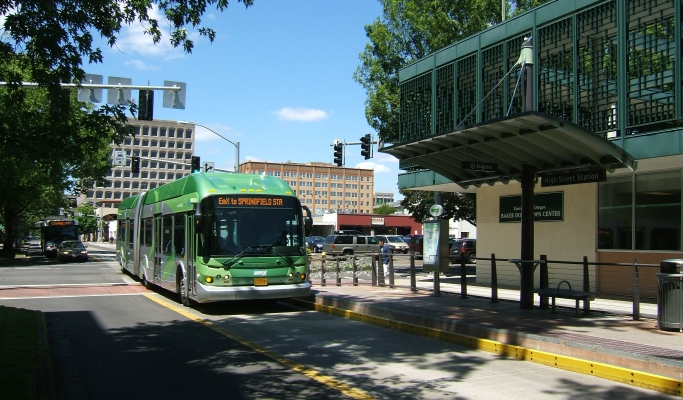Bus Rapid Transit (BRT) boosts property values in Eugene, Oregon

A new NITC report examines the property value impacts of Lane Transit District’s Emerald Express (EmX), a Bus Rapid Transit, or BRT, system that connects downtown Eugene to Springfield, Oregon.
BRT is often seen as an economically powerful transit option, providing high-speed service with a generally lower price tag than a light rail system. It seems intuitive that a location-efficient area, with transportation access boosted by BRT, would be an economically desirable place to live; offering access to jobs, shopping and other destinations. Little research, however, has been done recently in the United States examining to what extent BRT affects property values.
The goal of the latest NITC study, led by Victoria Perk and Martin Catalá of the Center for Urban Transportation Research at the University of South Florida in partnership with Lane Transit District and the Florida Department of Transportation, was to provide a more robust understanding of how BRT services in the U.S. affect surrounding residential property values.
The final report, Impacts of Bus Rapid Transit (BRT) on Surrounding Residential Property Values, found that the EmX line had a statistically significant positive impact on property values, which stands to benefit the community as a whole: the related taxes can be used to pay for transportation and other infrastructure, further enhancing the economic development of the community.
These related benefits, referred to as ‘marginal effects,’ have a positive impact on the livability of the community. This research shows that the closer a residence is to a BRT station, the greater the marginal effects on its estimated sale price.
The project is significant on a national scale because it is only the third U.S. study on this particular topic for the BRT mode within the last ten years. Two other relatively recent econometric studies using similar techniques have been published on BRT systems in Pittsburgh and Boston; this study represents the first of its kind on the West Coast.
“Pittsburgh is a Midwest Rust Belt city; Boston is a larger city with a long history of significant public transit; and now we’re looking at Eugene which is another different type of city: smaller, university town, West Coast. So it’s kind of neat to be adding another example of how BRT is impacting housing prices in different cities,” Perk said.
Overall, the findings suggest that proximity to the EmX BRT stations contributes to a small (but increasing), statistically significant positive impact on the actual market sale prices of area single-family homes.
One of the more interesting aspects of the findings is that the effects of the BRT stations on the sale prices of single-family homes is increasing over time, as the EmX service continues to mature.
This is a strong result, but Perk cautions that different characteristics of cities mean that every economic modeling effort is distinct.
“Performance evaluation is always tricky because each city has its characteristics that make it very unique. It’s so hard to say that what one city is doing will work in another city exactly the same way. It’s not going to be exactly the same,” Perk said.
For this reason, Perk recommends that future research continue to approach this question using additional data sources and techniques.
For more information, visit the project page or download the final report.
